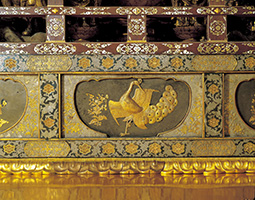October 2022
- English
- 日本語
The Golden Hall of Chuson-ji Temple

The Konjikido (Golden Hall) at Chuson-ji Temple (Chuson-ji Collection) 
The shumidan altar of the Konjikido (Golden Hall) surrounded by four makibashira pillars (Chuson-ji Collection)

Close-up of one of the gilded peacock motifs on the altar (Chuson-ji Collection)

Chuson-ji Temple is a World Heritage Site located in Hiraizumi Town, Iwate Prefecture, in the Tohoku region of northeast Japan. On the temple grounds there is the Konjikido (Golden Hall), an example of kai-konjiki (all-gold) Buddhist architecture that is preserved in the same beautiful condition as when it was built almost 1,000 years ago.

Chuson-ji Temple is one of five components that make up the World Heritage Site of Hiraizumi Town, Iwate Prefecture, which was registered by UNESCO in 2011 under the inscription “Hiraizumi — Temples, Gardens and Archaeological Sites Representing the Buddhist Pure Land.” Principal among the treasures and cultural assets of Chuson-ji is the Konjikido Golden Hall, the only structure remaining in its original form from the 12th century when Hiraizumi was the political center of northeastern Japan (known as Oshu at the time, a large part of the present-day Tohoku region).
The Konjikido was built in 1124 by Fujiwara no Kiyohira, the founder of the Oshu-Fujiwara clan, and enshrines Amida Nyorai (the Buddha of Infinite Light). The Oshu-Fujiwara clan had earlier founded Chuson-ji as a large Buddhist temple complex. Kiyohira was deeply devoted to Buddhism and is said to have built the Konjikido, which measures around five-and-a-half meters on each side and around eight meters tall, to comfort the spirits of all those who died during the region’s long-lasting power struggle in the latter half of the eleventh century. In particular, he sought to create in Hiraizumi a peaceful realm, or Buddhist Pure Land, building temples, gardens and ponds. As a symbolic manifestation of the Pure Land at Chuson-ji, almost everything on the interior and exterior of the Konjikido, including the Buddhist ritual utensils, was entirely covered with gold, a style known as “kai-konjiki” (all gold).
Starting with Kiyohira, three generations of the Oshu-Fujiwara clan ruled the present-day Tohoku region, but then war broke out again, and in 1189 the young city of Hiraizumi was almost entirely destroyed. Remarkably, however, the Konjikido escaped that calamity. It risked devastation many times, but thanks to the joint efforts of the monks, various forms of aid, protection and restoration by rulers and the powerful over the years, almost 90% of the structure and materials used when the Konjikido was first built still survive. Even after nearly 1,000 years, the building retains its original appearance, although it is now housed inside a larger building and protected behind glass.
Haseki Shinsho, a monk at Chuson-ji Temple, says, “You can see the sophisticated sensibility of Buddhist art from that time in the Konjikido, even in the smallest details. The founders likely brought in the best craftsmen from Kyoto to complete the work. Some of the decorations such as the raden (mother-of-pearl inlay)* are symbolic of the Buddhist art in the culture of the Oshu-Fujiwara.”
The shumidan altar, where the bodies of the three generations of Fujiwara leaders are enshrined, features peacock motifs shaped with a hammer and gilded with gold leaf. The relief-like three-dimensional forms are exquisite. Surrounding the altar are four makibashira pillars that are lavishly decorated with maki-e* lacquer, raden and gold. A copper altar fitting called the “kondo keman” featuring depictions of the mythical half-human, half-bird “karyobinga” said to inhabit the Pure Land softly shimmers with gold.

In the Travels of Marco Polo (c. 1300) the Venetian merchant and explorer describes a place called “Zipangu” (Japan) that he heard about while in China. There, the place was said to have “tremendous quantities of gold” and a “King’s palace roofed with pure gold.” One theory holds that the palace that Marco Polo heard about was the Konjikido.
Haseki comments, “It is true that a lot of gold was produced in this area allowing for its extensive use in the construction of the Konjikido, but there really is no historic basis for the ‘King’s palace’ theory at present.”
Nevertheless, looking at the dazzling Konjikido today, Haseki acknowledges that it is tempting to imagine that the “land of gold” reported by Marco Polo in the thirteenth century and dreamed about by explorers such as Christopher Columbus after him “might have been Hiraizumi.”
And the Konjikido Golden Hall, radiating the charm of the Pure Land, still attracts people today.
* See Highlighting Japan May 2022, “The History and Culture of Lacquer in Japan” https://www.gov-online.go.jp/eng/publicity/book/hlj/html/202205/202205_01_en.html

